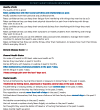Using a Patient Portal to Transmit Patient Reported Health Information into the Electronic Record: Workflow Implications and User Experience
- PMID: 27683669
- PMCID: PMC5019305
- DOI: 10.13063/2327-9214.1237
Using a Patient Portal to Transmit Patient Reported Health Information into the Electronic Record: Workflow Implications and User Experience
Abstract
Introduction: This project implemented an integrated patient self-reported screening tool in a patient portal and assessed clinical workflow and user experience in primary care practices.
Methods: An electronic health risk assessment based on the CMS Annual Wellness Visit (AWV) was developed to integrate self-reported health information into the patient's electronic health record (EHR). Patients enrolled in care coordination tested the implementation. The evaluation plan included quantitative and qualitative measures of patient adoption, provider adoption, workflow impact, financial impact, and technology impact.
Findings: Seventy-two patients completed the sample AWV, and 80% of the questionnaires had clinical findings that required provider follow-up. Patients expressed satisfaction with the portal, as it enabled them to view their health record and enter information. Implementation did not reduce office staff time. Providers and office staff agreed that an electronic system for adding information to their record would increase patient satisfaction, but they expressed concern with the need to promptly review the information and the time involved to accomplish this prior to an office visit.
Discussion: Despite satisfaction among patients, portal adoption is still low, due to technological limitations and to the lack of adaptability to primary care practice workflow. Notwithstanding those barriers, the use of the portal for completion of repetitive tasks, such as screening tools, should be encouraged.
Conclusions: Patients can effectively use portals to complete the patient reported section of the CMS AWV. However, if the information is not completed during the same day of the office visit, the time required to address health findings outside of a regular office visit is uncompensated, and diminished the enthusiasm for this process among primary care practice staff.
Keywords: Delivery of Health Care; Meaningful Use; Patient Portals; Patient-Centered Care.
Figures





Similar articles
-
Diffusion and Use of Tethered Personal Health Records in Primary Care.Perspect Health Inf Manag. 2015 Apr 1;12(Spring):1c. eCollection 2015. Perspect Health Inf Manag. 2015. PMID: 26755897 Free PMC article.
-
The Annual Wellness Visit Health Risk Assessment: Potential of Patient Portal-Based Completion and Patient-Oriented Education and Support.Innov Aging. 2024 Feb 29;8(3):igae023. doi: 10.1093/geroni/igae023. eCollection 2024. Innov Aging. 2024. PMID: 38618518 Free PMC article.
-
Patient Portals Facilitating Engagement With Inpatient Electronic Medical Records: A Systematic Review.J Med Internet Res. 2019 Apr 11;21(4):e12779. doi: 10.2196/12779. J Med Internet Res. 2019. PMID: 30973347 Free PMC article.
-
Building an electronic health record integrated quality of life outcomes registry for spine surgery.J Neurosurg Spine. 2016 Jan;24(1):176-85. doi: 10.3171/2015.3.SPINE141127. Epub 2015 Oct 2. J Neurosurg Spine. 2016. PMID: 26431073
-
Evaluation of a comprehensive EHR based on the DeLone and McLean model for IS success: approach, results, and success factors.Int J Med Inform. 2013 Oct;82(10):940-53. doi: 10.1016/j.ijmedinf.2013.05.010. Epub 2013 Jul 1. Int J Med Inform. 2013. PMID: 23827768 Review.
Cited by
-
Application of a user experience design approach for an EHR-based clinical decision support system.JAMIA Open. 2024 Mar 12;7(1):ooae019. doi: 10.1093/jamiaopen/ooae019. eCollection 2024 Apr. JAMIA Open. 2024. PMID: 38646110 Free PMC article.
-
The impact of eHealth use on general practice workload in the pre-COVID-19 era: a systematic review.BMC Health Serv Res. 2024 Sep 19;24(1):1099. doi: 10.1186/s12913-024-11524-9. BMC Health Serv Res. 2024. PMID: 39300456 Free PMC article.
-
Assessing the Needs and Perspectives of Patients With Asthma and Chronic Obstructive Pulmonary Disease on Patient Web Portals: Focus Group Study.JMIR Form Res. 2018 Nov 22;2(2):e22. doi: 10.2196/formative.8822. JMIR Form Res. 2018. PMID: 30684436 Free PMC article.
-
Pragmatic Clinical Trial of Population Health, Portal-Based Depression Screening: the PORTAL-Depression Study.J Gen Intern Med. 2023 Mar;38(4):857-864. doi: 10.1007/s11606-022-07779-9. Epub 2022 Sep 20. J Gen Intern Med. 2023. PMID: 36127535 Free PMC article. Clinical Trial.
-
Feasibility of a quality-improvement program based on routinely collected health outcomes in Dutch primary care physical therapist practice: a mixed-methods study.BMC Health Serv Res. 2024 Apr 24;24(1):509. doi: 10.1186/s12913-024-10958-5. BMC Health Serv Res. 2024. PMID: 38658939 Free PMC article.
References
-
- Tang PC, Lansky D. The missing link: bridging the patient–provider health information gap. Health Affairs. 2005;24(5):1290–1295. - PubMed
-
- CHILMARK RESEARCH Labs, PHRs, Platforms & Consumer Engagement: A Presentation. 2009. [cited 2015 12 December]; Available from: http://www.chilmarkresearch.com/2009/03/18/labs-phrs-platforms-consumer-....
-
- MANHATTAN RESEARCH Analyzing Digital Health by the Numbers: Five Years of Market Trends – and What They Mean for the Next Five. 2009. [cited 2015 December 12]; Available from: http://www.webcitation.org/6C9YLekWK.
-
- Centers for Medicaid and Medicare Services Meaningful Use Stage 2. 2012.
Grants and funding
LinkOut - more resources
Full Text Sources
Other Literature Sources
